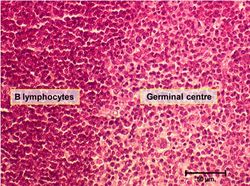B cells
Also known as B lymphocytes
So named as they were initially found in the Bursa of Fabricius, B cells produce antibodies and are associated with humoral immunity (T cells are part of the cell-mediated immune response), and are an integral part of the adaptive immune system. They represent 20-30% of circulating lymphocytes.
B cells have cell surface proteins known as B cell receptors (BCRs) that are known as immunoglobulins; IgM is the membrane bound BCR that is expressed when the B cell is immature, changing to IgD when the cell is mature. IgM has a large molecular mass and can bind up to 10 antigens simultaneously. B cells also express MHC II, CD9, CD,19, CD20 and CD24.
Under antigenic stimulation B cells differentiate into plasma cells and memory cells.
B-cells also act as Antigen-Presenting Cells (APCs) by presenting digested fragments to T cells on MHC II.
| Originally funded by the RVC Jim Bee Award 2007 |
Error in widget FBRecommend: unable to write file /var/www/wikivet.net/extensions/Widgets/compiled_templates/wrt662b8884cb2117_62750742 Error in widget google+: unable to write file /var/www/wikivet.net/extensions/Widgets/compiled_templates/wrt662b8884cf3176_50908437 Error in widget TwitterTweet: unable to write file /var/www/wikivet.net/extensions/Widgets/compiled_templates/wrt662b8884d27482_56420221
|
| WikiVet® Introduction - Help WikiVet - Report a Problem |
